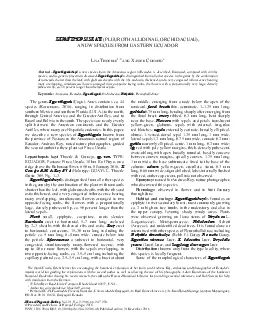

LI THOERLE12AVIER a new species from the Amazonas region in Ecuadoris described illustrated compared with similar species and its generic placement discussed is distinguished from all other species in ID: 867982
Download Pdf The PPT/PDF document "The genus Cogn Ames contains ca 44 speci..." is the property of its rightful owner. Permission is granted to download and print the materials on this web site for personal, non-commercial use only, and to display it on your personal computer provided you do not modify the materials and that you retain all copyright notices contained in the materials. By downloading content from our website, you accept the terms of this agreement.
1 The genus (Cogn.) Ames contains ca. 44 s
The genus (Cogn.) Ames contains ca. 44 species (Karremans, 2016), ranging in distribution from southern Mexico and southern Florida (U.S.A.) to the north, through Central America and the Greater Antilles, and to Brazil and Bolivia in the south. The species are nearly evenly split between the American continents and the Greater Antilles, where many are Hispaola endemics. In this paper, we describe a new species of , known from the province of Pastaza in the Amazonas natural region of Ecuador. Andreas Kay, noted nature photographer, guided Lepanthopsis kayi Thoerle & Cornejo, sp. nov. LI THOERLE 1,2 AVIER , a new species from the Amazonas region in Ecuador,is described, illustrated, compared with similar species, and its generic placement discussed. is distinguished from all
2 other species in the genus by the combi
other species in the genus by the combination 1. Lepanthopsis kayi Thoerle & Cornejo. , habit; , detail of a basal sheath; , partial in�orescence; , dissected �ower, lip , ovary, lip, and column, lateral view. Drawing by L. Thoerle, based on the Holotype.ARVARDOTAN. 21, N are intermediate between those associated with the Luer noted that the �owers of the two genera were “very similar to, if not indistinguishable from” one another, distinguishing usually longer than the leaves, with lepanthiform sheaths characterized by ciliate or scabrous ribs and ostia, with the ostia dilated (Luer, 1990, 1991). In spite of the �oral similarities, a recent assessment of the phylogenetic relationships within the subtribe Pleurothallidinae
3 places the two genera in different af&#x
places the two genera in different af�nities: is part of the Lindl. af�nity; Sw. The ramicauls of are much shorter than the leaves, 5–7 mm long vs. the 15–30 mm long leaf, growths have the thickened veins and ostia associated with the genus While the character of the in�orescence is not uniform in either genus, with some species of L. astrophora (Rchb.f. ex Kraenzl.) Garay, displaying the loose, �exuous raceme a few species of display the very congested in�orescence more often seen in the genus The �owers of the former are arranged either in a dense cylinder, as in Platystele densi�ora P. Ortiz, or in a raceme that is more or less umbellate, such as P. Ortiz. No species currently assigned to d
4 isplays �owers in two opposit
isplays �owers in two opposite-facing ranksThe in�orescence of with overlapping �owers arranged in two ranks with most open simultaneously, is characteristic of There are two similarly vegetatively anomalous species When Stenzel described Platystele hyalinathe glabrous sheaths of the ramicauls led to its generic placement, although he noted that the sheaths were ribbed and thickened, as in the genus (Stenzel, 2002)Recently, Karremans et al. (2016) transferred this species to , based largely on these sheaths. This species is readily differentiated from by its lax in�orescence THOERLE AND CORNEJO, NEW SPECIES OF LEPA URE 2. Thoerle & Cornejo. Plant with in�orescence. Photographed by Andreas Kay, from the type population.